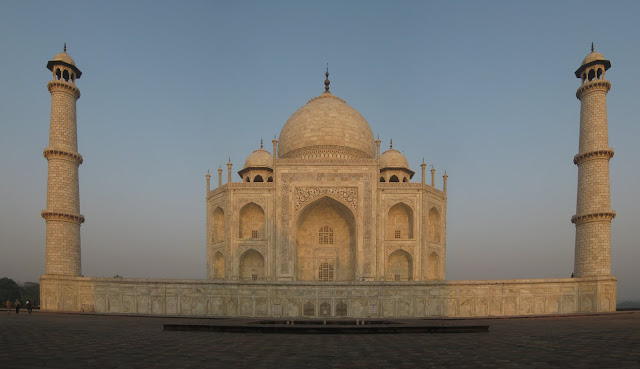Time for another wrap-up. Normally we do a Top 10, a Bottom 5, and our 5 Favorite Food and Drinks. However, wild-and-crazy India needs a Top 10, a Bottom 10 and a 10 Favorite Food and Drinks. We’ll try and keep it short as this is a lot to cover. Here we go!
Top Ten
-
Staying with Sasank in Delhi – Great guy, generous host, wonderful apartment. Lucky us.
- Holi – A holiday like no other. Kinda like dyeing Easter eggs, but with us being the Easter eggs.
- Rooftop sitting – Drinking chai, escaping the insane streets and enjoying sunsets.
- Udaipur Cooking Class – First cooking class experience was both informational and a lot of fun. Who wants to taste what we learned when we get home?
- Meherangarh Fort – We can confidently say that this is our favorite fort in the whole world.
One doesn’t usually have strong feelings about forts, but this fort just knocked our socks off.
- Camel safari sunset – How could you not love a beautiful sunset over rolling hills of sand that you arrived at by camel?
- Sikh Love – Didn’t meet a Sikh we didn’t like!
- Border closing ceremony antics – Though it might have been wrong to laugh so hard at something not aimed to be funny, we did and it was.
- Taj at sunrise – She’s a beaut and at that hour we had the place mostly to ourselves.
- India’s unbridled energy – Though a vague concept, there is no place else like India. Its uniqueness and intensity are at times overwhelming, but ultimately that’s what makes it so rewarding.
Bottom Ten
- Delhi belly – We’d toughened up our stomachs a little bit before arriving, but Delhi/India toughened them up a bit more.
- Obnoxious salesmen who won’t take no for an answer – Rickshaw? No, thank you. Rickshaw? No. Rickshaw? NOOO!!!!
- Salesmen that blatantly lie – Did you know that Richard Gere has visited this hole-in-the-wall textile shop in Jodhpur and that Giorgio Armani sources his fabric from this same place?
- Salesmen that are syrupy sweet nice when they are trying to make a sale that become rude or hostile when they realize that you aren’t going to buy anything.
- Filth – Really gross stuff. I don’t even want to write some of it down because it’s so gross. But imagine garbage, cow poo, public urination and the smells that go with it.
-
Poverty – There is such a gap between the Haves and the Have Nots and it’s unavoidable to see. People literally live in improvised dwellings on the sidewalks of streets while others are driving by in their Audis. It’s just brutal to see with your own eyes.
- Car horns – Though the horns make lots of different clever sounds, they are all loud and all overused. A walk or a bus ride on any road is hard on the ears after about 5 minutes.
- Everything is a negotiation/nothing is straightforward
- Different prices for foreigners – This is institutionalized. Sure our rickshaw drive will be pricier than for the locals, however, everything from the Humanyan’s Tomb to the Taj Mahal has a significantly higher sticker price for us non-Indians.
- Staring – Unnerving, to say the least. I know most folks don’t mean any harm, it’s just weird to be brazenly watched for no particular reason.
Favorite Food and Drinks – We primarily ate vegetarian in India as Hindus don’t eat meat, thus it is a very easy thing to do. However, once in awhile a chicken curry was in order!
-
Masala Chai – Or simply chai tea, if you will. It’s prolific, it’s delicious and it’s cheap. We drank some every day.
- Lassis – Pretty much a yogurt milkshake. I particularly liked banana lassis for breakfast!
- Aloo Parantha – Speaking of breakfast, this is what we liked to eat. It is an Indian bread stuffed with seasoned potatoes served with curd (yogurt) and pickles (chili sauce) for dipping.
- Naan – Or roti or parantha. At home we always ate garlic naan with our curries but we found out in India that naan is usually only served for special occasions. For everyday eating it is either roti or parantha (same thing but called by different names in different regions).
- Thalis – A medley of different curries, if you will, served with rice, bread and sometimes a dessert. Most restaurants serve unlimited refills, however, we usually split one between the two of us because it was so much food.
-
Butter Chicken – Chicken in a creamy, tomato curry. Mmm!
- Masala Dosas – Super thin pancakes/crepes wrapped around some curry.
- Curries in general – So many options and oh-so-good. Even mediocre food in India is better than most great Indian food at home.
- Gulab Jamun – Pretty much a donut hole soaked in a sweet syrup.
- Pakora – Deep-fried battered pieces of vegetable. Hard to not like.
Don’t forget to check out our Best of India photos.



